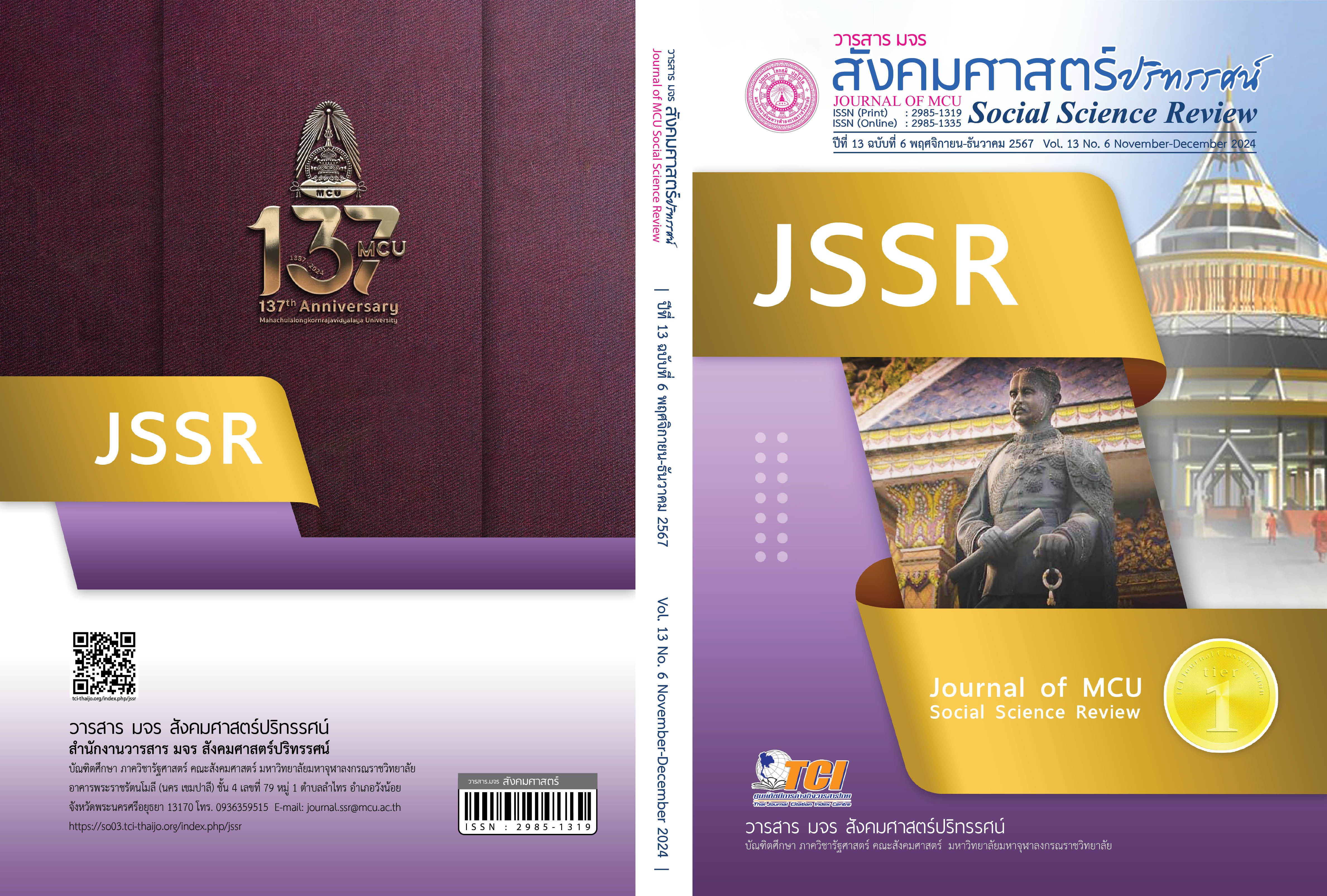LEARNING THAT PROMOTES THE ABILITY TO CRITICAL THINKING AND PLOBLEM SOLVING USING SOCIOSCIENTIFIC ISSUE ABOUT USING CHEMICAL KNOWLEDGE TO SOLVE PROBLEMS FOR 12TH GRADE
Keywords:
Critical Thinking and Solving Problems, Socioscientific Issue Social Issues Related to ScienceAbstract
This research article aimed: 1. To study instructional approaches that promote critical thinking and problem-solving skills by using socio-scientific issues, and 2. To examine critical thinking and problem-solving skills through socio-scientific issues, specifically the application of chemical knowledge to problem-solving, among 44 Grade 12 students. The research instruments included: 1. lesson plans that incorporated socio-scientific issues, 2. a learning reflection form, and 3. a critical thinking and problem-solving skills assessment. This study employed classroom action research, collecting data through three action research cycles. The qualitative data were analyzed using content analysis, while quantitative data were analyzed using basic statistics, such as mean and standard dofeviation.
The research findings revealed that: 1. Instructional approaches that promoted critical thinking and problem-solving skills through socio-scientific issues should involve situations that did not yet have clear solutions and require consensus-building to suit the students' context. These approaches could be applied to everyday life. 2. Students' critical thinking and problem-solving skills significantly improved after the learning intervention, with an increase by 81.81 percent.
References
กระทรวงศึกษาธิการ. (2564). แนวทางการยกระดับคุณภาพการผลิตและการพัฒนาครูปฐมวัยในสถาบันอุดมศึกษาของไทย. กรุงเทพฯ: สำนักงานเลขาธิการสภาการศึกษากระทรวงศึกษาธิการ.
ดารารัตน์ มากมีทรัพย์. (2553). การศึกษาผลการคิดอย่างมีวิจารณญาณและผลสัมฤทธิ์ทางการเรียนด้วยการเรียนแบบผสมผสานโดยใช้กระบวนการแก้ปัญหา วิชาการเลือกและการใช้สื่อการเรียนการสอนของนักศึกษาระดับปริญญาตรี. กรุงเทพฯ: มหาวิทยาลัยศิลปากร.
ทิศนา แขมมณี และคณะ. (2544). วิทยาการคิด. กรุงเทพฯ: เดอะมาสเตอร์กรุ๊ป แมนเนจเม้นท์.
ธนภูมิ พุ่มจันทร์. (2555). การพัฒนาทักษะการคิดอย่างมีวิจารณญาณ เรื่องประเด็นทางสังคม ของนักเรียนชั้นมัธยมศึกษาปีที่ 6 โดยใช้รูปแบบการจัดการเรียนรู้แบบซักค้าน(วิทยานิพนธ์ศึกษาศาสตรมหาบัณฑิต สาขาวิชาการสอนสังคมศึกษา). กรุงเทพฯ: มหาวิทยาลัยศิลปากร.
บรรจง อมรชีวิน. (2556). การคิดอย่างมีวิจารณญาณ : Critical Thinking : หลักการพัฒนาการคิดอย่างมีตรรกะ เหตุผล และดุลยพินิจ. นนทบุรี: อมรินทร์ บุ๊ค เซ็นเตอร์.
ปุณณวัช ทัพธวัช. (2555). การพัฒนาผลการเรียนรู้เรื่อง กฎหมายอาญาน่ารู้ และทักษะการติดอย่างมีวิจารณญาณของนักเรียนชั้นมัธยมศึกษาปีที่ 3 ด้วยการจัดการเรียนรู้แบบใครสิกขา (วิทยานิพนธ์ศึกษาศาสตรมหาบัณฑิต สาขาวิชาการสอนสังคมศึกษา). กรุงเทพฯ: มหาวิทยาลัยศิลปากร.
พัชราพร จามรี และลฎาภา ลดาชาติ .(2021). ความสามารถในการคิดอย่างมีวิจารณญาณเรื่องปัญหาสิ่งแวดล้อมของนักเรียนชั้นมัธยมศึกษาปีที่ 6. ศึกษาศาสตร์สาร มหาวิทยาลัยเชียงใหม่, 5(1), 28-43.
พิชญา ศิลาม่อน และฤดีรัตน์ บุษณะโชติ. (2562). ผลการเรียนรู้โดยใช้ประเด็นทางสังคมที่เกี่ยวเนื่องกับวิทยาศาสตร์เป็นฐานที่มีต่อความสามารถในการให้เหตุผลเชิงวิทยาศาสตร์ของนักเรียนมัธยมศึกษาตอนต้น. กรุงเทพฯ: จุฬาลงกรณ์ มหาวิทยาลัย.
วิจารณ์ พานิช. (2553). วิถีการสร้างการเรียนรู้เพื่อศิษย์ (พิมพ์ครั้งที่ 3). กรุงเทพฯ: มูลนิธิสดศรีสฤษด์วงศ์.
วีรยุทธ์ ชาตะกาญจน์. (2015). การวิจัยเชิงปฏิบัติการ Action Research. วารสารราชภัฏสุราษฎร์ธานี, 2(1), 29-49.
สถาบันส่งเสริมการสอนวิทยาศาสตร์และเทคโนโลยี. (2565). เกี่ยวกับ PISA. สืบค้น 24 พฤศจิกายน 2565, จาก https://pisathailand.ipst.ac.th
สุคนธา โคตรโสภา และคณะ. (2559). การเปรียบเทียบความสามารถในการโต้แย้งและการคิดเชิงวิพากษ์วิจารณ์หลังเรียนประเด็นปัญหาสังคมที่ใช้วิทยาศาสตร์โดยรูปแบบผสมผสานตามวิธีปัญหาเป็นฐาน และวิธีวัฏจักรการเรียนรู้ 5 ขั้น ของนักเรียนชั้นมัธยมศึกษาปีที่ 5 ที่มีผลการเรียนชีววิทยาต่างกัน. วารสารช่อพะยอม มหาวิทยาลัยราชภัฏมหาสารคาม, 27(2), 113-126.
อนุชา แป้นจันทร์. (2556). การจัดการเรียนรู้แบบใช้บริบทเป็นฐานร่วมกับการใช้ข่าวเป็นสื่อ เรื่องสภาพสมดุลเพื่อพัฒนาการรู้เรื่องวิทยาศาสตร์ของนักเรียนชั้นมัธยมศึกษาปีที่ 4.วารสารวิชาการศึกษาศาสตร์, 18(2), 31-44.
Herrington, R. et al. (2013). A Guide to Authentic e-Learning. London: Routledge.
Partnership for 21st Century skills (2015). P21 framework definitions. Retrieved October 13, 2019, from http://www.p21.org/our-workp21-framework
Posner, G. J. (1992). Analyzing the curriculum. New York: McGraw-Hall, lnc.
Smit, J. et al. (2012). conceptualisation of whole-class Scaffolding. British Educational Research Journal, 39(5), 817–834.
Vieira, R. M. et al. (2011). Critical thinking: Conceptual clarification and its importance in science education. Science Education International, 22(1), 43-54.
Watson, G. & Glaser, E. M. (1964). Wattson - Glaser Critical Thinking Appraisal Manual. New York: Harcourt, Brace and World.
Zeidler & Sadler. (2011). Global sustainability and public understanding of science: The role of socioscientific issues in the international community. Asia-Pacific Forum on Science Learning and Teaching, 12(1), 1-12.
Zeidler, D. L. & Nichols, B. H. (2009). Socioscientific Issues: Theory and Practioce. Journal of Elementary Science Education, 21(2), 49-58.
Zeidler, D. L. et al. (2009). Advancing reflective judgment through socioscientific issues. Journal of Research in Science Teaching. The Official Journal of the National Association for Research in Science Teaching, 46(1), 74-101.
Downloads
Published
How to Cite
Issue
Section
License
Copyright (c) 2024 Journal of MCU Social Science Review

This work is licensed under a Creative Commons Attribution-NonCommercial-NoDerivatives 4.0 International License.
In order to conform the copyright law, all article authors must sign the consignment agreement to transfer the copyright to the Journal including the finally revised original articles. Besides, the article authors must declare that the articles will be printed in only the Journal of MCU Journal of Social Sciences. If there are pictures, tables or contents that were printed before, the article authors must receive permission from the authors in writing and show the evidence to the editor before the article is printed. If it does not conform to the set criteria, the editor will remove the article from the Journal without any exceptions.





